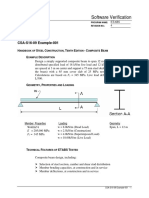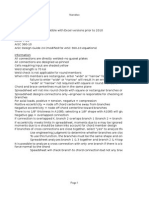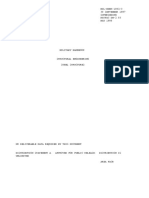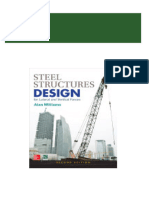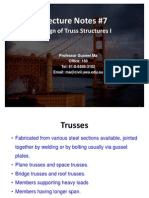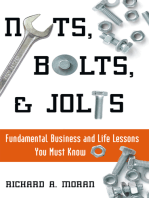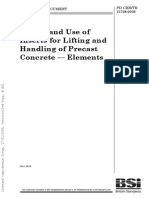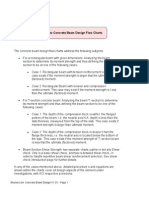Welds Ex 1
Welds Ex 1
Uploaded by
dicktracy11Copyright:
Available Formats
Welds Ex 1
Welds Ex 1
Uploaded by
dicktracy11Copyright
Available Formats
Share this document
Did you find this document useful?
Is this content inappropriate?
Copyright:
Available Formats
Welds Ex 1
Welds Ex 1
Uploaded by
dicktracy11Copyright:
Available Formats
ENG 7704 Design of Steel Structures
(CAN/CSA-S16-09)
Welding Ex.1.p.1
Welded connection: Example 1
Ex: Design a welded connection to carry the full tension capacity of 2PL10x200. Solution:
Alternative 1: Assume a lap joint and fillet welds along the width.
(t-2) D / 2 t D
Data: Fy = 345 MPa (350W Steel), Fu = 450 MPa It is customary to choose the weld metal to have a matching strength with plate metal. Choose E49XX electrode to match the weld metal to the plate metal. Xu=490 MPa (E49XX) b = 200 mm, t = 10 mm max weld size D < t-2mm Weld line angle with the direction of force Overlap = 50 mm (5t, 25 mm) Plate capacity: Path 1-1: Yielding of gross c/s Tr = AgFy = resistance factor for steel = 0.9 Ag = gross c/s area = bt Tr = 621 kN
Dr. Seshu M.R. Adluri
Table 6-3, Handbook
Table 3-22, Handbook
= 90o
Welding practice, sec.6 Handbook
Cl. 13.2 (a)(i) Cl. 13.1(a)
ENG 7704 Design of Steel Structures
(CAN/CSA-S16-09)
Welding Ex.1.p.2
overlap
D D Tf t
Tf
Path 2-2:
Rupture of net c/s. No net section for this case.
There is no shear lag effect since the ends of the plate are welded. Hence the entire plate width receives the force uniformly. Weld design: In the present case, the required size of the weld is unknown. We do not know if the weld needs to be placed on both the overlap lines for the entire width of the plate. We will assume that the weld is placed on the full width and compute the size. If the size comes out to be too small, we can increase the weld size and reduce the weld length. If the weld size comes out to be too great for the thickness of the plate, we need to increase the length of the weld by creating other lines of weld. The welds are in fillet weld configuration. Weld metal capacity: w = 0.67 Angle between weld line and applied force, = 90o Weld size, D (=?) Total fillet weld length, Lw = 2b Area of effective weld throat, Aw = LwD/2
Dr. Seshu M.R. Adluri
Cl. 13.1 (h)
ENG 7704 Design of Steel Structures
(CAN/CSA-S16-09)
Welding Ex.1.p.3
Vr = 0.67w Aw Xu(1 + 0.5 sin1.5)Mw > Tr of the plate Vr =0.67x0.67 (2x200xD/2)490 (1+0.5 sin1.590)1.0=93322D >621000 Base metal capacity: Area of effective weld contact with base metal, Am = LwD Vr = 0.67wAm Fu > Tf Vr = 0.67x0.67 (2x200xD) 450 = 80802D > 621000 Base metal capacity governs. Solving, D > 7.69 mm. Use 8 mm weld (=t-2 O.K) Note: we need not have done this calculation for weld metal since for 350W steel with matching electrodes, weld metal strength governs only if weld line angle is less than 45o with the direction of the applied force. If we needed extra capacity than this, we may need to provide longer fillet weld lines. A possible scheme is shown below.
overlap
Cl. 13.13.2.2
Cl. 13.13.2.2
Alternative 2: Try full penetration weld butt joint
cp Tf Tf t
Weld area for both base metal and weld metal, Aw = Am = bt Vr = 0.67w AmFu = 404.1 kN < Tr Not O.K. This complete penetration weld does not result in the required capacity unless a longer path is provided through slots, plugs, etc.
Dr. Seshu M.R. Adluri
Cl. 13.13.2.2
ENG 7704 Design of Steel Structures
(CAN/CSA-S16-09)
Welding Ex.1.p.4
Alternative 3: weld joint using splice plates
8 8 Tf Tf t 8 8
Splice plates allow the main plates to be in the same plane and avoid any eccentricity. The splice plate will have a combined area equal to the c/s area (or greater) of the base plate. Thus the splice plates will have enough tensile strength to carry the plate force. All calculations are as in the case of fillet weld alternative 1. The only difference is that we need extra plates and two extra welds of the same size. Because of the weld size, the splice plates have to remain 10mm thick. Otherwise, splice plates can have t/2 each. The length of the splice plate can be 50mm similar to the lap length. Use 2PL10x50x200 with 8mm fillet welds.
Dr. Seshu M.R. Adluri
You might also like
- Cisc Handbook of Steel Construction 11 Edition, 3 Revised Printing 2017 Revisions List No. 2 - 4 October 2017Document6 pagesCisc Handbook of Steel Construction 11 Edition, 3 Revised Printing 2017 Revisions List No. 2 - 4 October 2017hetpinNo ratings yet
- An Experimental Study of Block Shear Failure of Angles in TensionDocument11 pagesAn Experimental Study of Block Shear Failure of Angles in TensionSergioAlcantaraNo ratings yet
- CSA-S16-09 Example 001 PDFDocument8 pagesCSA-S16-09 Example 001 PDFMohamed Abo-ZaidNo ratings yet
- Steel StacksDocument2 pagesSteel Stacksdicktracy11No ratings yet
- Lifting Lug CalculationDocument5 pagesLifting Lug CalculationEm Mar100% (2)
- Connections 1 - Ch.2,3 Summarized Exercise Solutions (150-153)Document5 pagesConnections 1 - Ch.2,3 Summarized Exercise Solutions (150-153)travis8zimmermannNo ratings yet
- Brace Compression and Tension Capacity Design Charts As Per CSA S16 09 Rev1.5Document44 pagesBrace Compression and Tension Capacity Design Charts As Per CSA S16 09 Rev1.5Antonio LópezNo ratings yet
- Sfd-Csa-S16-14-60-117 Parte IiDocument58 pagesSfd-Csa-S16-14-60-117 Parte Iiedilberto lopezNo ratings yet
- 071-CG-01 Stair Case Design Report For AveryDocument16 pages071-CG-01 Stair Case Design Report For AveryK Divakara RaoNo ratings yet
- Canam Purlins and Girts Catalogue CanadaDocument42 pagesCanam Purlins and Girts Catalogue CanadaRodolfo ZazuetaNo ratings yet
- Hss WF Moment Conn 2.0 Final 1Document251 pagesHss WF Moment Conn 2.0 Final 1Lester BaculiNo ratings yet
- Column Web Shear Plate 14thEdAISCDocument47 pagesColumn Web Shear Plate 14thEdAISCMưa Vô HìnhNo ratings yet
- Moment Resistance Calculation of A Class 4 BeamDocument1 pageMoment Resistance Calculation of A Class 4 Beamsom_bs79No ratings yet
- SpliceDocument17 pagesSpliceSh MNNo ratings yet
- Truss Conn Final 1Document314 pagesTruss Conn Final 1amachmouchiNo ratings yet
- 68 36 300-1-SEABC C13 Session 4 Stability 2PerPageColorDocument127 pages68 36 300-1-SEABC C13 Session 4 Stability 2PerPageColorelidstone@hotmail.comNo ratings yet
- W14x43 To HSS6x6x1 - 2 Moment ConnDocument21 pagesW14x43 To HSS6x6x1 - 2 Moment ConnrajedmaglinteNo ratings yet
- Effective LengthDocument17 pagesEffective LengthJob NantawatNo ratings yet
- "Stiffner" - Steel Beam Web Stiffener Analysis: Program DescriptionDocument6 pages"Stiffner" - Steel Beam Web Stiffener Analysis: Program DescriptionGustavo PaganiniNo ratings yet
- 10-11 - Shear in BeamsDocument7 pages10-11 - Shear in BeamsOsama TamariNo ratings yet
- Check of Components According To CISC (Canadian Standards) - IDEA StatiCaDocument14 pagesCheck of Components According To CISC (Canadian Standards) - IDEA StatiCaNivar100% (1)
- cp4 ConnectionDocument127 pagescp4 Connectionznyaphotmail.com100% (1)
- CSA Seismic LoadsDocument3 pagesCSA Seismic Loadselidstone@hotmail.comNo ratings yet
- CSA Bolted Connection FatigueDocument3 pagesCSA Bolted Connection FatiguejurieskNo ratings yet
- Some Info On TrussesDocument9 pagesSome Info On TrussesameensderajNo ratings yet
- Steel StructureDocument70 pagesSteel Structureรศ.ดร.สมเกียรติ จตุรงค์ล้ําเลิศNo ratings yet
- Aisc 28Document4 pagesAisc 28Lyhalim SethNo ratings yet
- Esdep Lecture Note (Wg15)Document23 pagesEsdep Lecture Note (Wg15)mabuhamdNo ratings yet
- Composite Beam Design Metal DeckDocument9 pagesComposite Beam Design Metal Decksilveer12No ratings yet
- E26.To2 Steel PDFDocument10 pagesE26.To2 Steel PDFAmolsingh100No ratings yet
- Composite Girder Design Based On AISC 360-10/16 & 2019 CBC / 2018 IBCDocument2 pagesComposite Girder Design Based On AISC 360-10/16 & 2019 CBC / 2018 IBCridho ziskaNo ratings yet
- 4 Anchor Bolts Base PlateDocument285 pages4 Anchor Bolts Base Platetitir bagchiNo ratings yet
- تصميم الكمرات بطريقة ultimate PDFDocument42 pagesتصميم الكمرات بطريقة ultimate PDFqaisalkurdyNo ratings yet
- Chapter 3 - SP17 - 09-07 - Excluding MP Diagrams - PDFDocument17 pagesChapter 3 - SP17 - 09-07 - Excluding MP Diagrams - PDFMD. NASIF HOSSAIN IMONNo ratings yet
- Design of Steel StructuresDocument23 pagesDesign of Steel StructuresPraveenkumar ShanmugamNo ratings yet
- Connection Design - Its Role in Steel DetailingDocument9 pagesConnection Design - Its Role in Steel DetailingEduardo De Castro Cruz Jr.No ratings yet
- Moment Connection Using Mathcad PDFDocument11 pagesMoment Connection Using Mathcad PDFbong2rmNo ratings yet
- License Trouble Shooting Guide - Network - Disk IDDocument116 pagesLicense Trouble Shooting Guide - Network - Disk IDEmily StaffordNo ratings yet
- Compression Members - Local Buckling and Section Classification PDFDocument15 pagesCompression Members - Local Buckling and Section Classification PDFAnonymous lswzqloNo ratings yet
- Section Properties of Common ShapesDocument12 pagesSection Properties of Common Shapesdmaister1986No ratings yet
- Basement Column Supporting Lateral Resisting Frame Spreadsheet CalculationDocument3 pagesBasement Column Supporting Lateral Resisting Frame Spreadsheet CalculationPhanithNo ratings yet
- Full Download Steel Structures Design For Lateral and Vertical Forces, Second Edition Williams - Ebook PDFDocument41 pagesFull Download Steel Structures Design For Lateral and Vertical Forces, Second Edition Williams - Ebook PDFqinweiboodun100% (6)
- Bolted Connections LectureDocument65 pagesBolted Connections Lecturerghazzaoui1793100% (1)
- Mathcad - Tank Foundation Design Actions - 2611-501 & 502 - Rougher WMS Feed Tank 1 & 2Document15 pagesMathcad - Tank Foundation Design Actions - 2611-501 & 502 - Rougher WMS Feed Tank 1 & 2shashank sharmaNo ratings yet
- AISC Properties ViewerDocument1 pageAISC Properties ViewerAulia MirzaNo ratings yet
- Column Design Procedure PDFDocument26 pagesColumn Design Procedure PDFTamilNo ratings yet
- Torsion Validation ShayanDocument10 pagesTorsion Validation ShayanGicuNo ratings yet
- The Design Is Adequate.: W F F X X X y XDocument3 pagesThe Design Is Adequate.: W F F X X X y Xxuankhoi doanvanNo ratings yet
- Simply Supported Beam With Point LoadDocument5 pagesSimply Supported Beam With Point LoadGabriel WeissNo ratings yet
- Calculos Viga 6Document9 pagesCalculos Viga 6María Alejandra Velásquez PNo ratings yet
- Ductile Detailing of Beam As Per IS 13920Document4 pagesDuctile Detailing of Beam As Per IS 13920Civil FundaNo ratings yet
- Fram Master LinkDocument2 pagesFram Master LinknamasralNo ratings yet
- Design of Steel TrussDocument20 pagesDesign of Steel Trussapuhapuh_153349No ratings yet
- EccentricallyLoaded BoltedConnectionDocument15 pagesEccentricallyLoaded BoltedConnectionMikeNo ratings yet
- Connections I V2.1.0.a1Document49 pagesConnections I V2.1.0.a1gissel vicencioNo ratings yet
- Eccentric Shear Connection Analysis of Weld Group: Testing Spreadsheet Vs LRFD ManualDocument8 pagesEccentric Shear Connection Analysis of Weld Group: Testing Spreadsheet Vs LRFD ManualSudip ShresthaNo ratings yet
- Depth of Embedment of Sheet Pile Wall in Cohessiveless SoilDocument6 pagesDepth of Embedment of Sheet Pile Wall in Cohessiveless Soilmahmoud meslehNo ratings yet
- Introduction-Design-Guide 2Document16 pagesIntroduction-Design-Guide 2Sutha100% (1)
- Connections and Tension Member DesignDocument9 pagesConnections and Tension Member DesignVigneshwari MahamuniNo ratings yet
- Tension Members 2022Document44 pagesTension Members 2022ahmadlbraheem0987No ratings yet
- Lecture - 5 - Tension MembersDocument67 pagesLecture - 5 - Tension Membersayoub aliousalahNo ratings yet
- SDRM 1519Document1 pageSDRM 1519dicktracy11No ratings yet
- PD CEN-TR 15728 2008 Inserts For Lifting and Handling Precast ElementsDocument54 pagesPD CEN-TR 15728 2008 Inserts For Lifting and Handling Precast Elementsdicktracy11100% (1)
- Soil Loads On PipelinesDocument10 pagesSoil Loads On Pipelinesdicktracy11No ratings yet
- Bracket DesignDocument18 pagesBracket Designdicktracy11100% (2)
- Concrete Beam Design Flow ChartDocument16 pagesConcrete Beam Design Flow Chartdicktracy11No ratings yet
- 13 Songs You Wish You FoundDocument1 page13 Songs You Wish You Founddicktracy11No ratings yet


